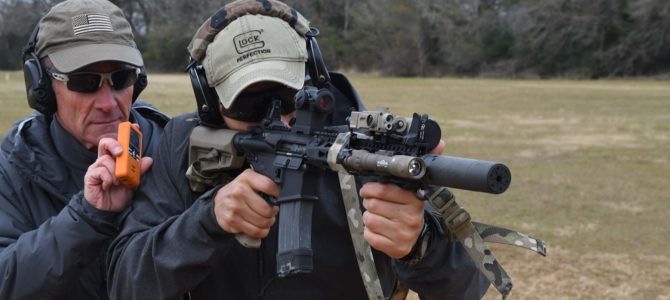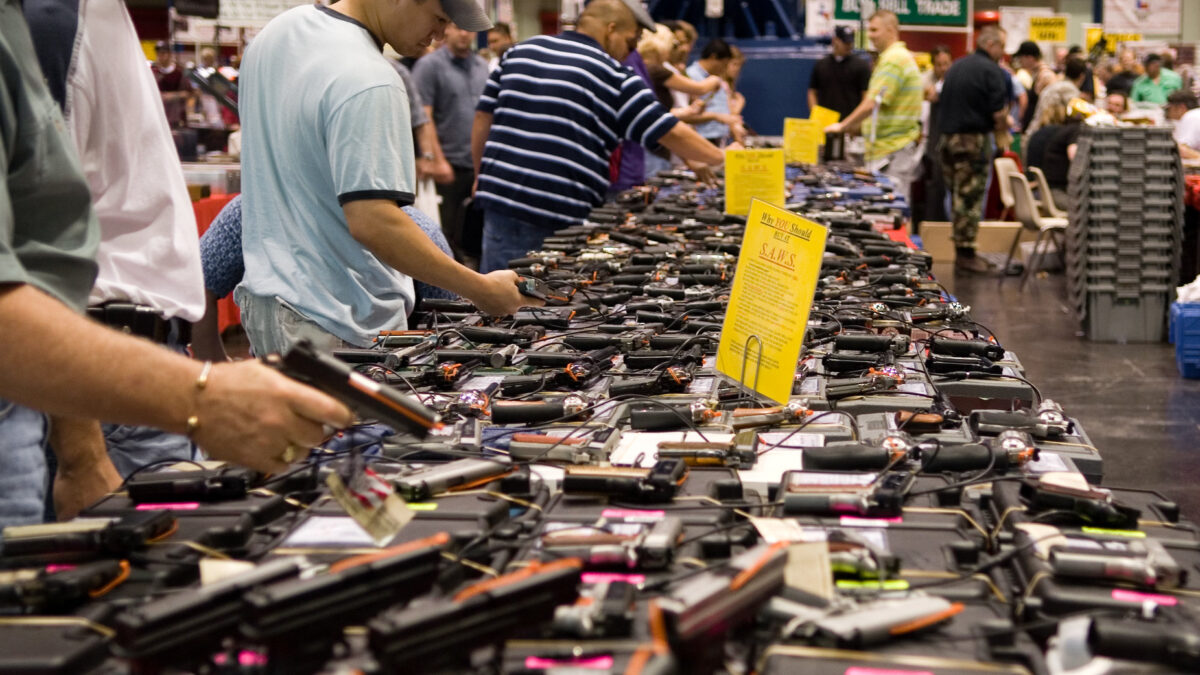
In a recent item for The Federalist, David Harsanyi considered the M16 rifle one of the five most innovative firearms in American firearm development history. Yet something equally significant can be said about the semi-automatic AR-15 derived from the M16. Second to the muskets used in our revolutionary and civil wars, the AR-15 may be the most important firearm in American political history.
All told, more Americans have fired more rounds from more AR-15s for personal defense, defensive firearm training, marksmanship competitions, individual practice, and hunting than from any other rifle. For that reason, the AR-15 is the primary firearm upon which Americans would rely if they had to fight for freedom today.
Here are 10 reasons to own at least one AR-15 and to become skilled in its use.
1. Being armed is your right and may be your civic duty.
On the one hand, for defense against common criminals, handguns can have advantages over the other two basic types of firearms: rifles and shotguns. Within and away from the home, a handgun carried in a holster is always within reach. Also, a handgun is more easily wielded with one hand, while the other hand dials 911; opens or closes a door; pulls, pushes, or carries someone to safety; or is injured.
In the 42 states that have fair procedures for issuing permits to carry firearms away from home or that don’t require a permit to do so, handguns are easier to carry because they are lighter and more compact, therefore more easily concealed. In addition, in some states, handguns are the only type of firearm a permit authorizes a person to carry.
On the other hand, common criminals are not the only threat, nor even the primary threat, because of which the Second Amendment prohibits government from infringing the right of the people to keep and bear arms. The late civil rights lawyer Don B. Kates, in “The Second Amendment and the Ideology of Self-Protection” (1992), explained why:
In the tradition from which the second amendment derives it was not only the unquestioned right, but a crucial element in the moral character of every free man that he be armed and willing to defend his family and the community against crime. . . . Moreover, arms were deemed to protect against every species of criminal usurpation, including ‘political crime,’ a phrase the Founders would have understood in its most literal sense. Whether murder, rape, and theft be committed by gangs of assassins, tyrannous officials and judges or pillaging soldiery was a mere detail; the criminality of [what Thomas Paine termed] the ‘invader and plunderer’ lay in his violation of natural law and rights, regardless of the guise in which he violated them.
2. The AR-15 is the most useful firearm with which to defend against ‘every species of criminal usurpation’ because, first and foremost, it is a rifle.
One day, new technologies in “arms”—“weapons of offense, or armour of defence,” according to a popular Founding-era dictionary—will be introduced, and we should object to the rationale the Supreme Court has established for upholding laws that would prohibit people from owning them. However, for the present, rifles are the type of firearm most useful for the entire range of defensive applications, which, in addition to defense against common criminals, includes the three historic purposes of the militia: repelling invasions, suppressing insurrections, and defeating tyranny, the latter the threat the Framers had in mind when they adopted the Second Amendment.
Most of us don’t have to worry about seaborne invasions today, because would-be invaders could not cross the Atlantic or Pacific oceans past our Navy, Coast Guard, and Air Force, and illegal entries into the United States via land routes are being handled by our Border Patrol; state, county, and local law enforcement officers; and National Guard (the militia’s organized component, unless federalized), with support from our military.
Most of us don’t have to worry about insurrections, either, except perhaps in Portland, Oregon, where police officers recently obeyed their Democrat mayor’s order—like German police did during Kristallnacht—to stand down while a leftist rabble attacked some people, threatened others, and destroyed property.
By process of elimination, that leaves being prepared to defeat tyranny as the most relevant of the militia’s purposes today, as James Madison and Alexander Hamilton envisioned in The Federalist Nos. 46, 28, and 29. That is to say, not to merely “resist” tyranny, as the late Justice Antonin Scalia, mischaracterizing Justice Joseph Story’s “Commentaries on the Constitution,” pretended in District of Columbia v. Heller (2008, pp. 24-25), and certainly not to do so unsuccessfully (Heller, pp. 55-56).
Being prepared to defeat tyranny is relevant for another reason. When the left achieves absolute power in a country, it murders its political opponents.
The best way to deny the left absolute power in America is by defeating its candidates in every election, from president to dog catcher. As the Chinese military theoretician Sun Tzu wrote in “The Art of War” 2,500 years ago, “to win without fighting is the acme of skill.” But as a precaution, we might be wise to remember the French and Indian War’s Maj. Robert Rogers’ “Rules of Ranging,” the second of which is, “Have your musket [yesteryear’s M16 or AR-15] clean as a whistle [and] be ready to march at a minute’s warning.”
In any event, rifles are the type of firearm most useful for the entire range of defensive applications because they are inherently more accurate than handguns and shotguns, are easier to shoot accurately, are more powerful across the greater distances at which they are effective, and can hold more rounds of ammunition. When armed with a rifle, a handgun’s primary purpose is to be ready in the holster in case the rifle runs out of ammunition or malfunctions.
3. The AR-15 is a semi-automatic rifle.
Having failed to get handguns banned in the 1970s, disarmament activists, Democrat politicians, and their supporters in the news media began vilifying semi-automatic rifles, a category of firearms introduced in the late 19th century. In the 1980s, The New York Times, Newsweek, and an anti-gun activist linked to domestic handgun prohibition and international disarmament groups claimed that semi-automatic rifles were popular with “private societies” of Christians and Jews, “paramilitary extremists,” “survivalists,” and other “fanatics of the far right.”
When such claims didn’t convince anyone other than fanatics of the far left, the anti-gunners began complaining instead that the rifles have pistol grips (like every handgun invented over the last few hundred years) and that some have adjustable-length stocks (like rifles used in Olympic and other precision-oriented marksmanship sports).
Ergonomic grips and stocks that are adjustable to the user’s physique and clothing can be advantages when firing a rifle. However, as explained by Maj. Gen. Julian S. Hatcher, former commanding general of the U.S. Army Ordnance Training Center and chief of Ordnance Training Service, in his 1947 book, “Hatcher’s Notebook,” the primary benefit of a semi-automatic rifle, as compared to a rifle requiring manual operation of its loading mechanism between shots, is that you can continue holding a semi-automatic rifle normally, keeping sight of your target, while it reloads itself, and be ready to aim your next shot once the rifle stops recoiling from the previous shot. This is particularly easy with the vast majority of AR-15s, in part because they use relatively lightly recoiling ammunition.
4. The AR-15 is one of the most validated rifles in history.
The Model 1898 Mauser, Lee-Enfield, Moisin-Nagant, and AK-47 probably win on this count, but the AR-15, introduced in 1963, isn’t very far behind. Americans privately own several million more AR-15 rifles and carbines than the number of M16s and carbine-variant M4s in military inventory, and they buy about 1 million new AR-15s every year.
Over the last 55 years, the AR-15 has been improved more often and in more ways than the M16 and M4, and today it is the most versatile semi-automatic rifle in history. It is more accurate and, properly maintained, more reliable than the supposedly ultra-reliable AK-47 and the legendary M1 “Garand,” which, during World War II, Gen. George S. Patton called “the greatest battle implement ever devised.” Furthermore, some AR-15s exceed military specifications for the M16 and M4 in terms of accuracy and quality controls related to durability and reliability.
5. The AR-15 is the most modular rifle in history.
AR-15s can be configured for the two practical purposes of firearms—fighting and hunting—or for competitions or informal practice. There are versions with rifle length, carbine length, and shorter barrels, some of which are designed to emphasize accuracy, some to emphasize durability. They can be had with fixed-length stocks or with the adjustable-length stocks Democrats don’t want you to have.
Slings designed for the AR-15 allow you to support the rifle across your front to be ready for use, stabilize the rifle when aiming, switch quickly between right-handed and left-handed shooting, quickly secure the rifle to your side when transitioning to your handgun, and secure the rifle across your back when you need both hands free to perform some other task.
AR-15s have the best iron sights ever invented for a fighting rifle, they’re commonly equipped with red dot and telescopic sights, and they can use night vision and thermal sights. They’re also commonly equipped with handguards that accommodate flashlights, visible lasers, infrared illuminators, and infrared lasers for use in low-light conditions.
All AR-15s—except for those manufactured during the 10 years the federal “ban” on so-called “assault weapons” was in effect, those manufactured in disfigured form to comply with the laws of several states dominated by Democrats, and a few others—have attachments that mitigate recoil, dissipate the puff of smoke and flash of light associated with firing a rifle, or both. Additionally, some of those attachments accommodate devices that reduce the loudness of gunshots, to protect your hearing and to make it easier to hear safety-related instructions when training or practicing on a supervised range.
6. In most cases, you can fix your AR-15 yourself.
If Never Trumpers, self-styled conservative purists, and “independents” don’t vote Republican in November 2020, and the following year a Democrat president and Congress ban AR-15s (for real, this time), you will be able to keep your previously acquired AR-15s running with a handful of relatively inexpensive, previously acquired parts that you can install yourself, without the services of a gunsmith. No other firearm, with the exception of the Glock pistol, is so easy to maintain.
Because the Democrats’ gun ban would include a ban on magazines holding more than 10 rounds and would cause a run on ammunition, you might be wise to also stock up on a dozen or more standard-equipment, 30-round magazines, several 20-round magazines, and a case or two of M193, M855, Mk 262, or Mk 318 ammunition, the primers and case necks of which are crimped and sealed for increased reliability.
One other thing: remember to watch out for the nuclear bombs that Democrat presidential hopeful Rep. Eric Swalwell wants the military to drop on you for refusing to hand your AR-15s over to the government.
7. The AR-15 is the rifle most commonly used for defensive firearm training.
Some people believe they are skilled with a gun because they own one. Fortunately, most never find themselves in situations in which that assumption costs them their lives. Anyone who is serious about being capable of using firearms proficiently for defensive purposes should take classes with instructors who specialize in defensive skills training. When you attend such classes, almost all of your instructors and fellow students will be using AR-15s.
8. The AR-15 is the rifle most commonly used for marksmanship competitions.
Some gun hobbyists think competitions are important for their own sake. However, from a defense-related perspective, competitions have value to the extent that they support training objectives and provide a venue for testing and validating product improvements.
As they are currently conducted, competitions have next to zero value in terms of offensive or defensive tactics training, but you can nevertheless benefit from participating in the action-oriented variety of them because they include target-shooting scenarios that will show you some of the skills in which you are weakest, thus upon which you need to work.
9. If you are skilled with your AR-15, you can help prepare young Americans for military service.
Want to “support our troops” in a tangible way? Get trained and share your knowledge with tomorrow’s uniformed warriors before they sign up for duty. The manual of arms for the AR-15 is identical to that of the M16s and M4s that are issued in the military. Recruits have to qualify with their rifles during basic training, and those who already have experience with the AR-15 will be ahead of the game in their knowledge of safety procedures, marksmanship, loading and unloading procedures, and malfunction clearing procedures.
10. The more Americans who own AR-15s, the more likely the Supreme Court will consider them “in common use.”
As I explained in an essay for The Federalist earlier this year, in Heller the Supreme Court incorrectly said that the Constitution protects the right of the people to keep and bear only such arms as are “in common use.” One of the many problems with that idea is that no matter how many AR-15s there are and how many Americans own them, judges and justices who don’t want you to have them can claim that they aren’t common enough to be considered “common.” However, until that portion of Heller is corrected, the more Americans who own AR-15s, the ever so slightly harder it will be for those judges and justices to do that with a straight face.









